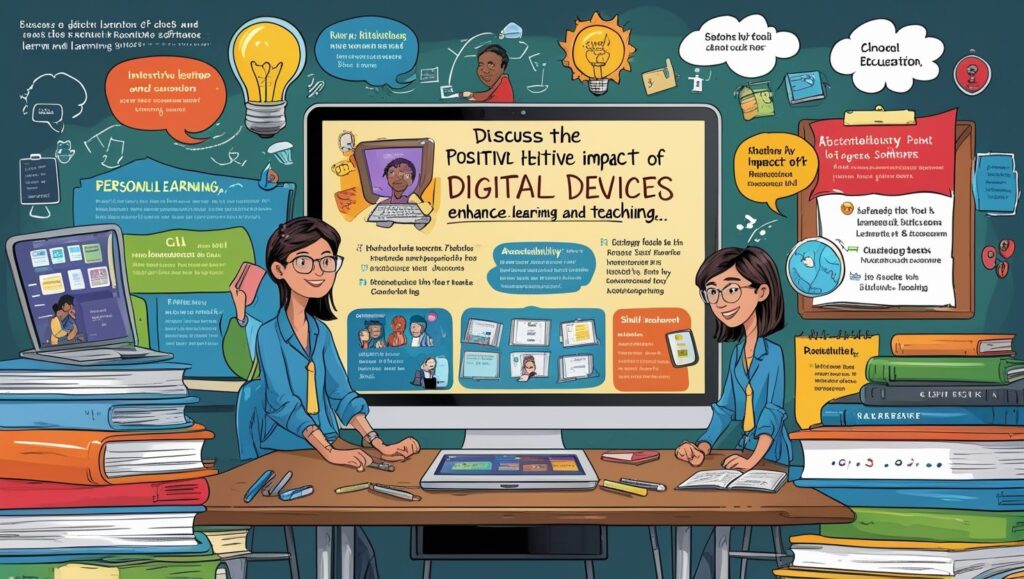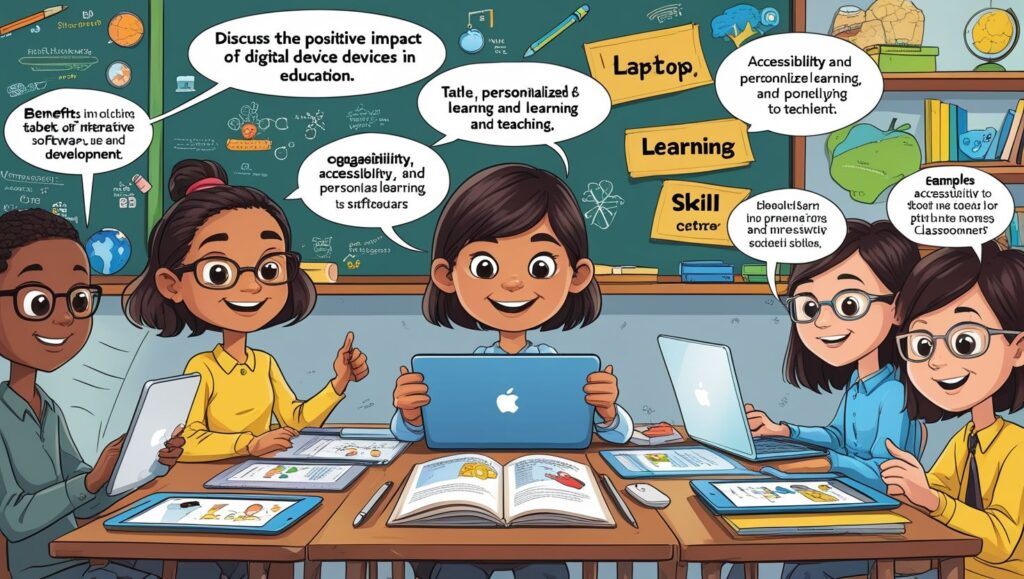The Positive Usage of Devices for Learning and Teaching in the digital age, mobile devices have revolutionized the way we live, work, and communicate. One of the most significant transformations has occurred in the field of education. Mobile technology has opened new avenues for learning and teaching, offering flexibility, accessibility, and a plethora of resources that were previously unimaginable. This article explores the positive aspects of using mobile devices in education, highlighting their impact on both students and teachers.
Accessibility and Convenience
One of the most prominent advantages of mobile devices in education is their ability to provide learning opportunities anytime and anywhere. With a smartphone or tablet, students can access educational materials, attend virtual classes, and complete assignments regardless of their physical location. This level of accessibility is particularly beneficial for students in remote areas or those with disabilities, as it eliminates geographical and physical barriers to education.
For teachers, mobile devices facilitate the distribution of course materials and the management of student progress. Educational apps and platforms allow educators to create and share content easily, communicate with students, and provide real-time feedback. This convenience enhances the teaching experience, making it more efficient and effective.

Personalized Learning
Mobile technology supports personalized learning, catering to the individual needs and learning styles of students. Adaptive learning apps use algorithms to adjust the difficulty level of tasks based on a student’s performance, ensuring that they are challenged but not overwhelmed. This personalized approach helps students to learn at their own pace and enhances their understanding of the subject matter.
Furthermore, mobile devices offer a variety of learning resources such as e-books, videos, and interactive simulations. These resources provide diverse perspectives and methods of explanation, enabling students to grasp complex concepts more easily. Teachers can also use these tools to tailor their teaching strategies to meet the needs of each student.
Engagement and Motivation
Mobile devices have the potential to increase student engagement and motivation. Educational games and apps turn learning into an enjoyable experience, capturing the interest of students and encouraging active participation. Gamification elements, such as rewards and progress tracking, motivate students to achieve their learning goals.
Interactive features of mobile devices, such as touchscreens and augmented reality (AR), make learning more interactive and immersive. For instance, AR apps can bring historical events to life or allow students to explore the human body in 3D. These engaging experiences foster a deeper connection with the subject matter and enhance retention of information.
Collaboration and Communication
Collaboration and communication are essential components of modern education, and mobile devices facilitate these aspects effectively. Students can collaborate on projects and assignments through cloud-based platforms, sharing documents and resources in real-time. Communication apps enable instant messaging and video conferencing, making it easier for students to work together and seek help from their peers or teachers.
For teachers, mobile devices provide a means to connect with students and parents outside the classroom. Communication apps and social media platforms allow educators to share updates, answer questions, and address concerns promptly. This continuous interaction fosters a supportive learning environment and strengthens the teacher-student relationship.
Lifelong Learning and Skill Development
The use of mobile devices in education extends beyond the classroom, promoting lifelong learning and skill development. With access to a vast array of online courses and tutorials, individuals can continue to learn new skills and expand their knowledge throughout their lives. Mobile devices enable learners to pursue their interests and passions at their own pace, making education a continuous and self-directed process.
For example, language learning apps provide interactive lessons and practice opportunities, allowing users to learn new languages on the go. Professional development platforms offer courses on various subjects, helping individuals to stay updated with industry trends and advance their careers. By facilitating continuous learning, mobile devices empower individuals to adapt to the changing demands of the modern world.

Challenges and Considerations
While the positive aspects of mobile devices in education are numerous, it is essential to address the challenges and considerations associated with their use. One of the primary concerns is the potential for distraction. The same devices that provide educational resources also offer access to social media, games, and other non-educational content. To mitigate this issue, it is crucial to implement policies and practices that promote focused and responsible use of mobile devices in educational settings.
Another concern is the digital divide, which refers to the gap between individuals who have access to technology and those who do not. Ensuring equitable access to mobile devices and reliable internet connectivity is essential to prevent disparities in educational opportunities. Schools and governments must work together to provide the necessary infrastructure and support for all students to benefit from mobile learning.
Data privacy and security are also critical considerations. The use of mobile devices involves the collection and storage of personal information, making it essential to implement robust security measures to protect student data. Educators and institutions must be aware of privacy laws and regulations and ensure that the apps and platforms they use comply with these standards.
Conclusion
The Positive Usage of Mobile Devices for Learning and Teaching the positive usage of mobile devices in education has transformed the learning and teaching landscape, offering unprecedented opportunities for accessibility, personalization, engagement, collaboration, and lifelong learning. By leveraging the power of mobile technology, educators can create dynamic and inclusive learning environments that cater to the diverse needs of students. However, it is essential to address the associated challenges and ensure that mobile devices are used responsibly and equitably. With the right strategies and support, mobile devices can continue to enhance education and empower learners for a brighter future.


aepmk6
rj69kq
yg51f5
ppcvut
7e80hw
Thank you for any other fantastic post. The place else could anyone get that kind of info in such a perfect approach of writing? I’ve a presentation subsequent week, and I am at the look for such information.
ttbek8
Platform Slot Gacor yang Membayar Besar dan Tepat Waktu, hanya di SIGMASLOT
Make mornings more adorable with this Hello Kitty alarm clock CD player. Ideal for kids and collectors alike, this charming CD clock radio includes all the basics: AM/FM radio, programmable CD playback, and reliable alarm settings. Wake up to your favorite CD or a cheerful radio station with built-in stereo sound. A large digital display and simple controls make it easy to use, even for younger users. Combining cuteness with functionality, it’s a top pick among themed alarm clocks with CD players that bring fun and joy to your space.
If some one wishes expert view on the topic of blogging afterward i suggest
him/her to visit this blog, Keep up the pleasant job.
My blog post nordvpn coupons inspiresensation
Some truly good blog posts on this web site, regards for contribution. “It is not often that someone comes along who is a true friend and a good writer.” by E. B. White.
This was really well done. I can tell a lot of thought went into making it clear and user-friendly. Keep up the good work!
I wish I had read this sooner!
Keep writing! Your content is always so helpful.
I’ve bookmarked this post for future reference. Thanks again!
This is now one of my favorite blog posts on this subject.
I love how practical and realistic your tips are.
I love the clarity in your writing.
I wish I had read this sooner!
Great article! I’ll definitely come back for more posts like this.
Great points, well supported by facts and logic.
I really appreciate content like this—it’s clear, informative, and actually helpful. Definitely worth reading!
I enjoyed your perspective on this topic. Looking forward to more content.
This topic really needed to be talked about. Thank you.
This was a great reminder for me. Thanks for posting.
This content is gold. Thank you so much!
This topic really needed to be talked about. Thank you.
This content is gold. Thank you so much!
Your writing always inspires me to learn more.
This was very well laid out and easy to follow.
Your writing always inspires me to learn more.
Thank you for making this topic less intimidating.
Keep educating and inspiring others with posts like this.
I’ve read similar posts, but yours stood out for its clarity.
This was really well done. I can tell a lot of thought went into making it clear and user-friendly. Keep up the good work!
I love how well-organized and detailed this post is.
Have you ever thought about creating an e-book or guest authoring on other blogs? I have a blog centered on the same information you discuss and would love to have you share some stories/information. I know my readers would value your work. If you are even remotely interested, feel free to send me an email.
lnza7i